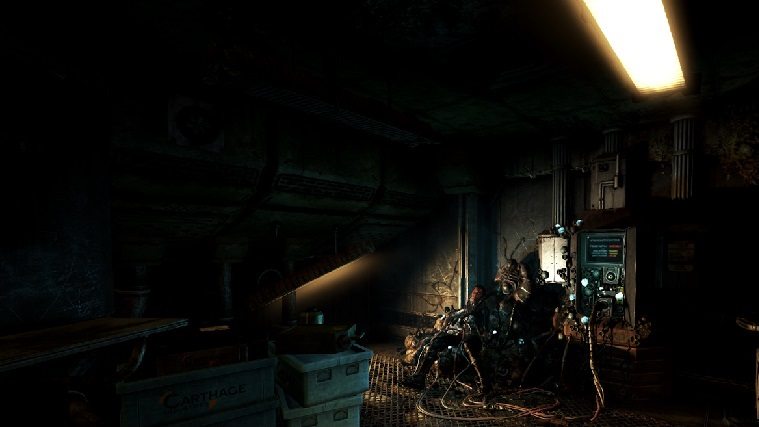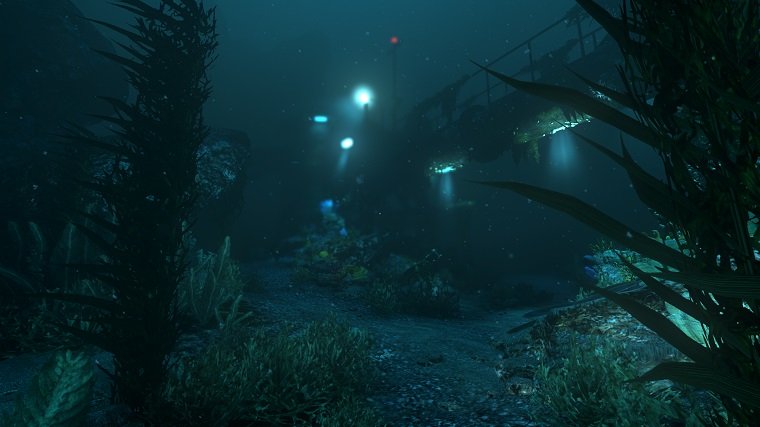Survival horror has never been renowned for delivering exceptional plot and scenery, at least when compared to AAA action/adventure titles. Above all else, developers tend to prioritize invoking fear in the form of darkness, desolation and jump scares, which is what Frictional Games has succeeded time and again in delivering. But SOMA sets itself apart from its predecessors in delivering one of the greatest, most unique adventures I’ve ever had the pleasure of experiencing in the genre. While still holding true to its legacy of terror, SOMA also explores a more personal, psychological avenue of horror.
Set in the not-so-distant future, players take the role of a confused and often morally conflicted Simon Jarrett as he creeps through the deteriorating infrastructure of Pathos-II: a mysteriously empty government facility at the bottom of the ocean. Simon quickly discovers that he is not, in fact, alone, but rather in the company of deranged robots and a lurking terror. Not far into the game you come in radio contact with Catherine Chun, who aids in guiding Simon throughout the game both physically and emotionally. Sometimes funny, but often uncomfortably dark dialogue between the two adds dimension to each character as they discuss the ambiguity of morality, human mortality and artificial intelligence. It is in these recurring themes that the game really gets into your head. The voice acting perfectly captured each characters’ emotions and contributed immensely to my immersion with the game. (Owners of a decent set of headphones would benefit greatly by utilizing the ‘headphones’ setting in the Options menu.)
Simon has a unique power that enables him to tap into the final conversations of the many corpses scattered throughout Pathos II. This phenomenon felt similar to the auditory hallucinations experienced in Amnesia: The Dark Descent. Between this, documents found in computer terminals as well as notes scattered throughout the game, players can learn as much as they care to outside of what is already revealed through standard story progression. Reliving events of the past uncover a solid understanding of your environment and shed just the right abundance of information regarding each and every operation once performed throughout your now dead environment. It certainly adds an eerie feel to such a large and complex web of facilities. Though bear in mind, some things prove to be best kept to the dead.

No combination of objectives felt the same, and every interaction with key objects offered some element of satisfaction
SOMA’s many puzzles involve interacting with a variety of futuristic technology. Though sometimes you’re tasked with the “find X amount of objects” mission, there is depth and complexity in each task that kept me at a safe distance from feelings of repetition. No combination of objectives felt the same, and every interaction with key objects offered some element of satisfaction; the click of a battery locking into place, the whirring buzz of computers and robots performing tasks, the hissing and clanking of gears and hydraulics as an airlock fills with or drains water, etc. all felt and sounded as close to realistic as I could imagine them being. And (without giving too much away) even the simple act of unplugging a cord to redirect power could leave me ridden with guilt.
The intended strategy of SOMA’s enemy encounters divert slightly from games like Alien: Isolation, Outlast or Amnesia. Simon’s inability to hide under objects or inside lockers often caught me off guard in situations where I needed it most. At first this came off as a negative aspect of the game. I clumsily crammed myself as deep and awkwardly as possible between desks and chairs before giving in and trying other approaches. As it turned out, there is much to learn about each individual enemy and the various methods of getting past them. The result was a more fluid and fast paced approach. Where in other games I’d spend upwards of around 2 minutes at a time safely cowering, SOMA had me constantly scrambling to the next goal.
Some instances even felt a little too easy at times. Getting caught doesn’t necessarily bring Simon back to the last checkpoint, but certain enemies will just leave him in the same spot after dealing heavy damage. This allowed me on some occasions to sprint to the nearest escape, obtain damage, and easily proceed to safety. But this was also rarely the case. Alternatively, Simon can retain damage and continue onward only to find the enemy right around the corner, poised to deal a final blow. Successfully escaping an encounter with damage taken left me frantically searching for health in the most disgusting places. In SOMA, recovering health unfortunately involves Simon plunging his fist into some pretty ugly sphincters found on walls… yeah, and Simon really enjoys it too… moving on.

Playing through SOMA on Playstation 4 proved to be somewhat challenging at times. This is in regards to the same issues that currently plague games like Fallout 4 and Just Cause 3. Auto saves can cause freezes for up to several seconds, which isn’t terrible as they usually occur in safe areas. The real annoyance was framerate drops, usually after some event is triggered. On one particular incident after completing an objective, framerate temporarily crippled my movement and I was captured by the enemy. After a horrifyingly slow death my game crashed. As this was my first in-game death, I felt a new horror emerge from these roaming monstrosities. Luckily, this turned out to be the only game crashing incident, although framerate still continued to act up at times.
As I progressed through SOMA’s 10 hour campaign the most impressive visual aspect was, of course, trekking along the bottom of the ocean. In many horror games I feel that environment, no matter how impressive, gets old after a period of time. Sure, trudging through the darkness with only a flashlight and a place to hide every 10 feet makes for a fun and exciting experience. I’ve enjoyed loads of horror games that offer only that. But for a game to really set the bar in my opinion, overcoming terrifying challenges should warrant more reward than just being able to access another area of a haunted mansion or asylum. In SOMA, multiple facilities are scattered across a vast and diverse ecosystem. You’ll find abandoned shipwrecks and cliffs leading into the abyss as you journey onward. Your means of transportation and overall experience in travel is as unique as each puzzle encountered along the way.
Overall, SOMA may not deliver as many jump-scares as the average survival horror, but Frictional Games took an intelligent approach to almost everything that went into this game. With the exception of framerate issues on PS4, SOMA is a beautifully polished marriage of adventure and sci-fi horror. Simon and Catherine, against all odds, making their way through unspeakable horrors for the preservation of humanity, all the while challenging the uncertainties of artificial psychology and the uncanny valley it resides in will surely keep players up at night asking themselves the questions that are too weird to bring up in social situations. If you’re up for a challenge and don’t mind having your brain prodded mercilessly along the way, SOMA is right for you.

The Verdict
With intelligent story telling and beautiful imagery, SOMA pushes the boundaries of traditional survival horror in new, psychologically thrilling ways. PS4 framerate issues may cause minor frustration during critical moments, but any console-limited fans of this niche genre are urged to give it a shot, regardless.











Published: Dec 20, 2015 09:14 am